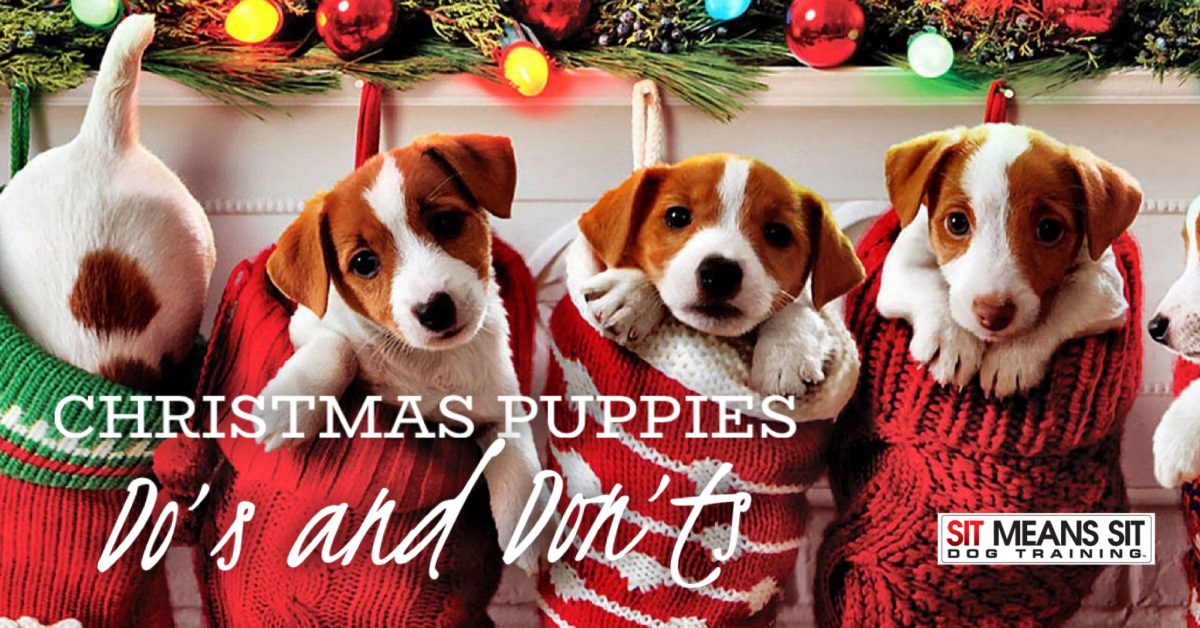
Puppies: Do’s and Don’ts This Christmas
“Happiness is a warm puppy.” – Charles M. Schulz
It’s the most wonderful time of the year! Toasty fires, tasty treats, lights and songs and cheer all around give us the warm fuzzies. Those warm fuzzies also lead many folks to seek out and bring home a new family member, especially of the puppy variety. Even before the holiday season began, we have seen a significant uptick in clients looking for puppy training and wanted to share some critical information for potential new puppy people to set both dog and human up for long-term success!
- First thing’s first: you have to be ready for a lifetime commitment! Puppies are cool and all, but they rapidly turn into dogs and dogs are expensive and require a great deal in terms of time and attention. The ASPCA estimates that the total first-year costs range from $1,314 and $1,843 on average, and that’s for veterinary costs alone. Thinking of buying someone you love a puppy? Anyone can fall in love with big eyes and soft coats, but please make sure they’re well equipped to handle puppyhood, not just financially, but also through meaningful preparations. For instance…
- …make sure that the breed of dog is appropriate for the handler’s lifestyle! A cute face does not necessarily make for an ideal fit. If you’re a homebody looking for some attention and affection at the end of a long day, but your work, kids, school, etc. take the majority of your time, a high-energy working dog may not be the right fit. Or if your significant other is an outdoorsperson extraordinaire and in love with a big ol’ bulldog, those expectations vs. reality analyses may come up a bit lopsided for both spouse and doggo. Engage other folks that own breeds you may be interested in, talk to vets and groomers if able, and even take advantage of online tools to help guide you in the right direction. We all make changes to accommodate our pets, but balanced expectations will only help to curb puppy frustrations before they start. And what do we do when we bite the bullet and make that big decision? We prepare for the basics, of course!
- The biggest frustration for new puppy clients is indubitably potty training. We whole-heartedly recommend crate training to begin this path. Crating has benefits outside of just puppy stuff, too; if your puppy is crate trained, then a boarding stay or recovery from injury has fewer barriers because they’ll already feel safe and comfortable when properly contained. The first thing we as puppies learn from mom is that we don’t pee and poo where we eat and sleep. The crate offers puppies a den to eat and drink while keeping them safely contained during potty breaks. When outside of the crate, housetraining is all about constant supervision and mindless repetition, so be prepared to follow your little around for a few months and adapt your routine to absorb that time!
- Once you’re headed down the right path to good potty habits, it’s time to focus on engagement and structured exposure! Most municipalities make leashes mandatory outside of the home, so early conditioning to wear and tolerate leash and collar are imperative from an early age. You can also use treats to lure puppies into desired behaviors like sits and downs to set up the foundations of obedience commands. Body and spatial awareness are critical to introductions to new environments and people, so get your puppy around new textures, levels, and noises and start straight away in handling paws and legs and ears to help make your vet tech and groomer’s job easier down the road.
- Speaking of introduction to new environments and people, let’s talk socialization! The idea behind socialization is that you want to help your puppy become acclimated to life in a positive manner. Proper socialization can prevent a dog from being fearful of children, for example, or to do well riding in a car or having good vet experiences, and it will help him develop into a well-mannered, happy companion. Socialization is often conflated with interaction, and while interaction is key, the foundations of socialization are rooted in tolerance. Understanding that simple fact can be key to the difference in the aforementioned positive acclimation versus putting a pupper into an unfamiliar group of circumstances and causing setbacks in maturation. The ideal is that we make the pup comfortable just being, no matter what’s going on around him!
All that being said, there’s little in the whole world that beats the look on someone’s face when they see their new dog for the first time. We only ask that you do your part to ensure that the first moment of joy isn’t fleeting but sustainable throughout puppyhood and beyond. Remember – PREPARE now so that you don’t have to REPAIR in the future!
Warmest of wishes from our family to yours this holiday! Never hesitate to reach out to see how we can help you and your newest family member through all stages of life!
